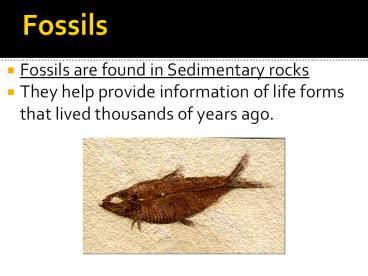Fossils - PowerPoint PPT Presentation
1 / 12
Title:
Fossils
Description:
Fossils are found in Sedimentary rocks They help provide information of life forms that lived thousands of years ago. Petrified Minerals have filled in where an ... – PowerPoint PPT presentation
Number of Views:60
Avg rating:3.0/5.0
Title: Fossils
1
Fossils
- Fossils are found in Sedimentary rocks
- They help provide information of life forms that
lived thousands of years ago.
2
Types of Fossils
- Petrified Minerals have filled in where an
organisms once was - Molds A hollow area that an organism has left.
- Cast A copy of the shape of the organism
(opposite of a mold) - Carbon Film a thin coating of carbon that is
left behind when gases have been release by the
decaying fossil (like a leaf print on a rock) - Trace An imprint that an organism left behind
(like a footprint)
3
Bones
- A fossil bone should have different canals and
webbed structure of the bone. - You can even try a tongue test. The porous nature
of some fossil bones will cause it to slightly
stick to your tongue if you lick it, though you
might want to have a glass of water handy if you
feel compelled to try this.
4
Petrified Fossils
- Fossils in which minerals replace all or part of
an organism. - How does this happen?
- Water rich in dissolved minerals seeped into
spaces, evaporated, leaving the hardened minerals
behind. - Example petrified wood
5
Molds and casts
- Most common type of fossil.
- Both copy the shape of the organism.
- A mold is a hollow area of sediment in the shape
of the organism. - A cast is a copy of the shape of an organism.
6
Carbon Films
- Carbon film is an extremely thin coating of
carbon - How does this happen?
- All organisms are made of carbon. When they are
buried, the materials that make up the organism
evaporates. These gases escape leaving carbon
behind.
7
Trace Fossils
- Trace fossils provide evidence of the activities
of ancient organisms. - Examples
- A footprint provide clues about the size and
behavior, the speed, how many legs it walked on,
lived alone or with others. - A trail or burrow can give clues about the size
and shape of the organism, where it lived, and
how it obtained food.
8
How old is it?
- Relative Age Its age when compared to others (
I am older than you) - Absolute age Its actual or real age
- We use radioactive dating to find this
- Unconformity a gap in the the geological record
(like from erosion)
9
Laws of Geologic History
10
Law of Superposition
- The oldest layer is at the bottom and the
youngest layer is at the top.
11
- Law of Crosscutting - In a series of horizontal
sedimentary beds, if there is an inclusion which
cuts vertically through them, it must be younger
than the sediment beds.
12
Law of Inclusions - The intruding rock (Rock A)
must have been there first to provide the
fragments in the younger rock (Rock B)

